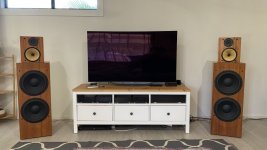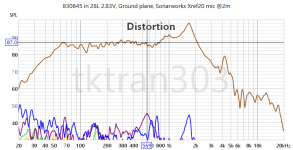Hi to all,
I plan to build a three way in a simplified form of Watt Puppy. I don't want to try to replicate it.
My question is should I use two 8 inch woofers or one 10 inch. We often say that there is no replacement for displacement. Also I beleive that a pair of 8 inchers will not sound the same as one 10. Even if the 8 inch pair has more displacement than the 10 inch by approx 30%. I aim to have deep yes but mainly articulate bass. On the downside, that a 10 inch facing driver is quite big visually (not to mention a 12 incher).
I have not chosen the other drivers yet. But I want top tier stuff!
Thanks for sharing your experiences,
Walter
I plan to build a three way in a simplified form of Watt Puppy. I don't want to try to replicate it.
My question is should I use two 8 inch woofers or one 10 inch. We often say that there is no replacement for displacement. Also I beleive that a pair of 8 inchers will not sound the same as one 10. Even if the 8 inch pair has more displacement than the 10 inch by approx 30%. I aim to have deep yes but mainly articulate bass. On the downside, that a 10 inch facing driver is quite big visually (not to mention a 12 incher).
I have not chosen the other drivers yet. But I want top tier stuff!
Thanks for sharing your experiences,
Walter
http://www.troelsgravesen.dk/Diy_Loudspeaker_Projects.htm
Have you seen Troels Gravesen’s kits, he has a number of both single and double Watt Puppy looking speakers and there are a rename of driver from the Scanspeak Discovery through to their Elipticor and also ones with Audio Technology and SB Acoustic drivers. Not sure if any are open source as he tends to sell kits through Jantzen (all price sheets linked on the speaker pages) but some were previously open source but now locked down, the way back machine may help.
Just a bit of inspiration or maybe a solution.
Have you seen Troels Gravesen’s kits, he has a number of both single and double Watt Puppy looking speakers and there are a rename of driver from the Scanspeak Discovery through to their Elipticor and also ones with Audio Technology and SB Acoustic drivers. Not sure if any are open source as he tends to sell kits through Jantzen (all price sheets linked on the speaker pages) but some were previously open source but now locked down, the way back machine may help.
Just a bit of inspiration or maybe a solution.
Considering that the increased minimum acoustic center to center distance of two 8" low drivers vs one 10" or 12" to the mid cone driver won't be of much concern with a crossover in the 300-400 Hz range, really comes down to displacement.My question is should I use two 8 inch woofers or one 10 inch.
Assuming the same excursion, 2x8" would have more displacement than a single 10", but less than a single 12".
Can you tell me a little more?Greets!
Depends on the XO point and desired polar response...........
A single good 10" can be cheaper than a couple of good 8" but if sealed using 2 woofers can give the option of using a 3.5 set-up, although copper cost for the large inductors can be a disincentive there.
Rule of thumb tho is that a good big woofer always beats a good small woofer unless WAF is the deciding factor
Rule of thumb tho is that a good big woofer always beats a good small woofer unless WAF is the deciding factor
Side mounted subwoofers force cancellation is useful to some extent, reducing the bracing required for a given amount of "shake", but side mounted woofers playing into the midrange generally don't sound great.My first thot was that 2 8s can be mounted push-push, a single 10 cannot
Wfr329 needs to define the low/mid crossover point, SPL output, low frequency extension and aesthetic goals to zero in on "what's best".
A bigger woofer beats a smaller woofer, agreed but a pair of slightly smaller woofers in parallel increases voltage sensitivity by 6dB. In any given system the woofers tend to be the limiting factor in terms of dynamic range (c.f midrange or tweeter)
Here’s my ‘Watt/Puppy’

A single woofer in test box:

A pair wired in parallel, in 100 L sealed cabinet be a 4ohm for modern amplifiers. And net in 92-93dB/2.83V /m between 60Hz and 380Hz.
Here’s my ‘Watt/Puppy’

A single woofer in test box:

A pair wired in parallel, in 100 L sealed cabinet be a 4ohm for modern amplifiers. And net in 92-93dB/2.83V /m between 60Hz and 380Hz.
but side mounted woofers playing into the midrange generally don't sound great.
Only good to 400-500 Hz.
dave
As has since been pointed out, the higher the XO point, the more critical the c-t-c spacing and dual vertical drivers will have an oblong polar response, i.e. narrower in height, wider horizontally Vs the spherical single driver, so depending on listening distance, speaker spacing in room the dual 8 might be bouncing off the walls in front of the listening position (LP) instead of behind it. Toeing them in can help, but may overlap too much in the middle, reducing stereo imaging if wide band or uneven response in the 'sweet' spot.Can you tell me a little more?
Here was the VituixCAD2 model of a single woofer, vs the actual measurement using a ground plane method at 2m, the black dotted line is the simulation, the blue is the measurement:

After this close correlation with actual measurements and simulation. So moving forward, to get rid of the pesky resonance we insert a notch filter.
And then a low pass filter to suit my midrange:

After this I was confident enough to move forward with putting a pair into 100L sealed cabinets. Here's is the VituixCAD2 simulation, taking into account full space (4pi) output and aforementioned filters.

Of course we finally lug out the speakers and take polar measurments. With a XO point of ~400Hz, the wavelength is a large 2.5m, so as GM mentioned, there will be some vertical directivity asymmetry. But it's quite minimal- certainly when the crossover is optimised for typical 10 ft listening distances... you can see it here:

I don't think anyone can call a 14" wide cabinet slim, but I was surprised that a pair of these 86dB, 8 ohm woofer s have the right balance of parameters for a sealed box design in 3.5cu ft (100L), 92dB/2.83V (4 ohm stable), anechoic F3/F6/F10 47/36Hz/30Hz.

I think this is one of reason why modern loudspeaker development has moved towards twin (or quad) woofers instead of a single woofers of yore- increased sensitivity (which I care about) and slimmer cabinets (which SAF/modern interior decorators may care about).
After this close correlation with actual measurements and simulation. So moving forward, to get rid of the pesky resonance we insert a notch filter.
And then a low pass filter to suit my midrange:
After this I was confident enough to move forward with putting a pair into 100L sealed cabinets. Here's is the VituixCAD2 simulation, taking into account full space (4pi) output and aforementioned filters.
Of course we finally lug out the speakers and take polar measurments. With a XO point of ~400Hz, the wavelength is a large 2.5m, so as GM mentioned, there will be some vertical directivity asymmetry. But it's quite minimal- certainly when the crossover is optimised for typical 10 ft listening distances... you can see it here:
I don't think anyone can call a 14" wide cabinet slim, but I was surprised that a pair of these 86dB, 8 ohm woofer s have the right balance of parameters for a sealed box design in 3.5cu ft (100L), 92dB/2.83V (4 ohm stable), anechoic F3/F6/F10 47/36Hz/30Hz.
I think this is one of reason why modern loudspeaker development has moved towards twin (or quad) woofers instead of a single woofers of yore- increased sensitivity (which I care about) and slimmer cabinets (which SAF/modern interior decorators may care about).
Last edited:
multiple woofers spread out any floor bounce problems, & 2x 8" give more total Sd than a single 10", along with a slimmer box if desired (all other things being equal - $$$, Fs, sensitivity etc...)
Definitely a single 10"
If you mess around with VituixCAD and set the height spacing correctly between the drivers you'll quickly find out that using two 8's will get you into a bunch of odd phase alignment issues. This is assuming you have them stacked on top of one another.
If you mess around with VituixCAD and set the height spacing correctly between the drivers you'll quickly find out that using two 8's will get you into a bunch of odd phase alignment issues. This is assuming you have them stacked on top of one another.
I think the answer lies in LF extension and loudness requirements. For most casual listening down to 30 Hz a single well-picked 8” will do, in case of a ported system. If you need louder and/or deeper lows, go for two. The difference between a single 8” and a single 10” isn’t that big in terms of max SPL (calculate it). And LF extension depends on system choice, not on woofer size.
multiple woofers spread out any floor bounce problems, & 2x 8" give more total Sd than a single 10", along with a slimmer box if desired (all other things being equal - $$$, Fs, sensitivity etc...)
This is the route I took. 2.5-way with 2x 8" drivers and a 1" compression driver. The 0.5-woofer is close to the floor, which improved the 80-200Hz "punch" area.
Chris
Only good to 400-500 Hz.
Since he wants to build a 3-way, that ought be enough, depending on the midrange ofc.
This is the route I took. 2.5-way with 2x 8" drivers and a 1" compression driver. The 0.5-woofer is close to the floor, which improved the 80-200Hz "punch" area.
That's a good way to improve the bass performance. That usually sounds a lot better than creating a upper bass hunch by the tuning/volume. Another possibility of the 0.5 is to compensate for the baffle step.
- Home
- Loudspeakers
- Multi-Way
- Two 8 inches or one 10?